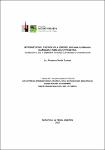| dc.contributor.advisor | Prina, Aníbal Oscar | |
| dc.contributor.author | Suyama, Alejandro Daniel | |
| dc.date.accessioned | 2023-08-31T13:04:04Z | |
| dc.date.available | 2023-08-31T13:04:04Z | |
| dc.date.issued | 2022 | |
| dc.identifier.uri | https://repo.unlpam.edu.ar/handle/unlpam/8579 | |
| dc.description.abstract | Lepechinia floribunda (Benth.) Epling, es un pequeño arbusto, presente en Sudamérica, desde Perú y Bolivia hasta la provincia de Buenos Aires, Argentina. Por sus características florales y vegetativas presenta un buen potencial para ser incorporada como planta ornamental, tanto en el mercado viverista, como para su uso en jardines de especies nativas. En este trabajo se tomó registro de los ambientes naturales donde crecen las poblaciones de esta especie. Se obtuvieron muestras de seis poblaciones principalmente de la ladera oeste de las Sierras de Los Comechingones, sobre las provincias de Córdoba y San Luis. Se estudiaron el desarrollo de estacas y germinación de semillas de cuatro de las poblaciones elegidas. Para las estacas se contempló la respuesta a fitohormonas de enraizamiento y época del año: otoño-invierno y primavera-verano. Las fitohormonas utilizadas fueron ácido naftalenacético (ANA) y ácido indolbutírico (IBA) en concentración 1000 ppm (partes por millón). En cuanto a las semillas se registró el peso de 1000 semillas y el poder germinativo por cada población y en diferentes campañas de colecta. Se evaluó también respuesta de las plantas expuestas a diferentes condiciones de luz. Se registraron las fenofases de la especie en la región y la producción de semillas durante este periodo. Se tomó nota de posibles variantes de color y seguimiento de los cambios en la corola. Los ensayos de multiplicación agámica en otoño, no generaron estacas con raíz. Para los esquejes de primavera se obtuvo un bajo número de estacas enraizadas (3,9%). De los nueve esquejes sobrevivientes, seis habían sido tratados con IBA y dos con ANA. El poder germinativo total de las semillas fue de 20,47% siendo superior a lo informado por otros autores. No hubo diferencias significativas entre poblaciones y temporadas. El ensayo a diferentes condiciones de luz tampoco mostró diferencias significativas entre tratamientos. La media general de producción semillas en el periodo más productivo fue de 632±110 semillas por planta. Se establecieron 10 fenofases y el periodo de máxima floración entre noviembre y diciembre. The species studied here, Lepechinia floribunda (Benth.) Epling, is a small shrub, that grow in South America, from Peru and Bolivia to Buenos Aires province in Argentina. Due to its floral and vegetative features, it presents good potential to be incorporated as an ornamental plant, both in the plant nursery trade, and for use in gardens of native species. In this work, a record was taken of the natural environments where the populations of this species grow. Samples were obtained from six populations mainly from the western slope of the Sierras de Los Comechingones, at Córdoba and San Luis provinces. The development of cuttings and seed germination of four of the chosen populations were studied. For the cuttings, the response to rooting hormones and season was considered: autumn-winter and spring-summer. The hormones used were naphthaleneacetic acid (ANA) and indole butyric acid (IBA) in 1000ppm (parts per million) concentration. Regarding the seeds, the weight of 1000 seeds and the germination power were recorded for each population and in different season collections. The response of plants exposed to different light conditions was also evaluated. The phenophases of the species in the region and the production of seeds during this period were recorded. Possible colour variants were noted and changes in the corolla were monitored. The agamic multiplication trials in autumn did not generate rooted cuttings. For the spring cuttings, a low number of rooted cuttings was obtained (3.9%). Of the nine surviving cuttings, six had been treated with IBA and two with ANA. The total germination power of the seeds was 20.47%, being higher than that reported by other authors. There were no significant differences between populations and seasons. The test at different light conditions did not show significant differences between treatments either. The general average of seed production in the most productive period was 632 ± 110 seeds per plant. 10 phenophases were established and the period of maximum flowering between November and December. | |
| dc.format.extent | 1 recurso en línea (104 páginas) : Ilustraciones, gráficas, fotografía; | |
| dc.format.medium | application/pdf | |
| dc.language.iso | spa | |
| dc.rights | Atribución-NoComercial-CompartirIgual 2.5 Argentina (CC BY-NC-SA 2.5 AR) | |
| dc.rights.uri | https://creativecommons.org/licenses/by-nc-sa/2.5/ar/ | |
| dc.subject.other | Botánica | |
| dc.title | Introducción al cultivo de la especie Lepechinia Floribunda (Lamiaceae) para uso ornamental = Introduction to crop of Lepechinia floribunda (Lamiaceae) for ornamental use | |
| dc.type | tesis de posgrado | |
| dc.unlpam.subtype | trabajo final | |
| dc.unlpam.carrera | Magíster en producción agropecuaria en regiones semiáridas | |
| dc.unlpam.instituciondeorigen | Facultad de Agronomía | |
| dc.unlpam.access | openAccess | |
| dc.unlpam.version | publisherVersion | |
| dc.unlpam.filiacion | Suyama, Alejandro Daniel. Universidad Nacional de La Pampa. Facultad de Agronomía, Argentina. | |
| dc.unlpam.sigtop | 635.1 | |
| dc.subject.palabraclave | Multiplicación sexual | |
| dc.subject.palabraclave | Multiplicación agámica | |
| dc.subject.palabraclave | Estados fenológicos | |
| dc.unlpam.institucionotorgante | Universidad Nacional de La Pampa. Facultad de Agronomía | |











